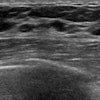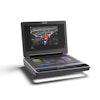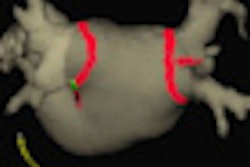SAN DIEGO - Ultrasound can accurately evaluate superficial soft-tissue masses, according to a presentation Thursday at the American Institute of Ultrasound in Medicine (AIUM) annual meeting.
Researchers from the University of Wisconsin School of Medicine and Public Health in Madison found that ultrasound can be utilized to diagnose subcutaneous lipomas with a high degree of accuracy, sensitivity, and specificity. Sonographic features such as wavy echogenic lines, a wider-than-tall shape, minimal to no Doppler signal, and a lack of acoustic shadowing were most helpful in diagnosing lipoma, said presenter Dr. Jason Wagner.
Soft-tissue tumors occur at an incidence of three in 1,000 adults and are increasingly leading to imaging evaluation. Although superficial structures are well visualized by ultrasound, previous research has reported a substantial variation in the modality's accuracy in diagnosing soft-tissue masses, Wagner said.
Seeking to evaluate the diagnostic accuracy of ultrasound in evaluating superficial masses and to determine the sonographic features that are most characteristic of lipomas, the researchers performed a three-phase study involving cases performed by Wagner during a previous stint as a radiologist at the 72nd Medical Group clinic at Tinker Air Force Base in Oklahoma.
Between August 1, 2005, and November 15, 2008, Wagner evaluated 62 patients with 72 superficial masses. Breast lesions, organ-based lesions, obvious joint-related ganglion cysts, and morphologically normal lymph nodes were not included in the study.
The patients included 26 females and 36 males with an age range of 6 to 64 years and a mean age of 35.
All patients received sonographic evaluation using an Acuson Sequoia scanner (Siemens Healthcare, Malvern, PA) with a 15 LH transducer, with the studies performed by Wagner.
In the first phase, the study team retrospectively reviewed ultrasound exams and patient records, comparing the initial diagnosis with the reference standard of the final pathology. In cases involving two foreign bodies and six hernias, the surgical procedure note was used as the standard because no tissue was resected.
Thirty-nine lipomas were found during surgical treatment and histologic examination, including four angiolipomas and one fibrolipoma. Also discovered were six hernias, four hemangiomas, four foreign bodies, three epidermal inclusion cysts, three benign fibrotic lesions, two neurofibromas, one accessory breast tissue, one aneurysm (superficial temporal artery), one endometriosis, one ganglion cyst, one hematoma, one Hodgkin's lymphoma, one pilar cyst, one pilomatricoma versus foreign body reaction, one venous malformation, and one venous thrombus.
The preoperative sonographic diagnosis was concordant with the pathology findings in 67 cases (93%). For the specific diagnosis of lipoma, ultrasound yielded 96% accuracy, 97% sensitivity (one false negative), and 94% specificity (two false positives).
The second phase of the study involved a reader review by three attending radiologists with an interest in ultrasound. Blinded to the surgical outcome/pathology findings, the readers were provided with patient demographic information, body side, and clinical history. They viewed all of the ultrasound images and classified each case on a per-lesion basis into one of 14 diagnostic categories.
Results were similar to the first phase of the study. Overall, the three readers had concordant diagnoses with pathology findings of 89%. In diagnosing lipomas, the three readers turned in accuracy of 94%, sensitivity of 97%, and specificity of 91%.
In the final phase of the study, images were reviewed for lesion characteristics including echogenicity, borders, shape, homogeneity, internal features, Doppler signal, shadowing, deep acoustic enhancement, edge artifact/refractive shadowing, and size.
All lipomas were wider than tall, had minimal or no internal Doppler signal, and had no acoustic shadowing; 30% of nonlipoma lesions had at least partial shadowing. The researchers also found wavy echogenic lines in 29 of 39 (74%) lipomas and four of six hernias; this feature was not present in any other lesions.
In other findings, six (15%) lipomas were hypoechoic, 23 (59%) were isoechoic, and 10 (26%) were hyperechoic.
Wagner acknowledged a number of limitations in the study, including its reliance on only subcutaneous lipomas. There was also only one malignancy in the study and no elderly patients, and the cases were generated from a primary care referral base; results may differ in a major referral center, Wagner said. In addition, the characterization of imaging features was not performed by a blinded reader.
"Further study would be helpful to validate these results in another setting and to potentially look at the cost-effectiveness of this approach for superficial masses," Wagner said.
By Erik L. Ridley
AuntMinnie.com staff writer
March 26, 2010
Related Reading
Osteopath proselytizes for musculoskeletal US, November 11, 2004
Copyright © 2010 AuntMinnie.com




















